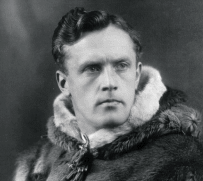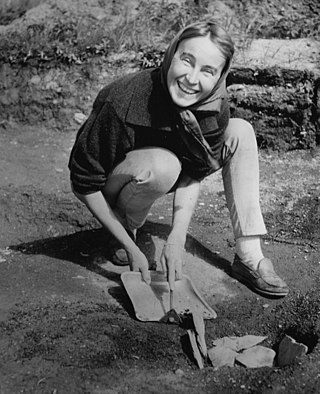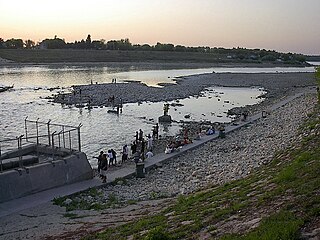
Vinland, Vineland, or Winland was an area of coastal North America explored by Vikings. Leif Eriksson landed there around 1000 AD, nearly five centuries before the voyages of Christopher Columbus and John Cabot. The name appears in the Vinland Sagas, and describes Newfoundland and the Gulf of Saint Lawrence as far as northeastern New Brunswick. Much of the geographical content of the sagas corresponds to present-day knowledge of transatlantic travel and North America.

Leif Erikson, also known as Leif the Lucky, was a Norse explorer who is thought to have been the first European to set foot on continental America, approximately half a millennium before Christopher Columbus. According to the sagas of Icelanders, he established a Norse settlement at Vinland, which is usually interpreted as being coastal North America. There is ongoing speculation that the settlement made by Leif and his crew corresponds to the remains of a Norse settlement found in Newfoundland, Canada, called L'Anse aux Meadows, which was occupied approximately 1,000 years ago.

Helge Marcus Ingstad was a Norwegian explorer. In 1960, after mapping some Norse settlements, Ingstad and his wife archaeologist Anne Stine Ingstad found remnants of a Viking settlement in L'Anse aux Meadows in the province of Newfoundland in Canada. They were thus the first to prove conclusively that the Icelandic/Greenlandic Norsemen such as Leif Erickson had found a way across the Atlantic Ocean to North America, roughly 500 years before Christopher Columbus and John Cabot. He also thought that the mysterious disappearance of the Greenland Norse Settlements in the 14th and 15th centuries could be explained by their emigration to North America.

The Norse exploration of North America began in the late 10th century, when Norsemen explored areas of the North Atlantic colonizing Greenland and creating a short term settlement near the northern tip of Newfoundland. This is known now as L'Anse aux Meadows where the remains of buildings were found in 1960 dating to approximately 1,000 years ago. This discovery helped reignite archaeological exploration for the Norse in the North Atlantic. This single settlement, located on the island of Newfoundland and not on the North American mainland, was abruptly abandoned.

Carolyn Merchant is an American ecofeminist philosopher and historian of science most famous for her theory on The Death of Nature, whereby she identifies the Scientific Revolution of the seventeenth century as the period when science began to atomize, objectify, and dissect nature, foretelling its eventual conception as composed of inert atomic particles. Her works are important in the development of environmental history and the history of science. She is Distinguished Professor Emerita of Environmental History, Philosophy, and Ethics at UC Berkeley.

The Parks Canada Agency, is the agency of the Government of Canada which manages the country's 48 National Parks, three National Marine Conservation Areas, 172 National Historic Sites, one National Urban Park, and one National Landmark. It is more commonly known by its applied title "Parks Canada". Parks Canada is mandated to "protect and present nationally significant examples of Canada's natural and cultural heritage, and foster public understanding, appreciation, and enjoyment in ways that ensure their ecological and commemorative integrity for present and future generations".

Helluland is the name given to one of the three lands, the others being Vinland and Markland, seen by Bjarni Herjólfsson, encountered by Leif Erikson and further explored by Thorfinn Karlsefni Thórdarson around AD 1000 on the North Atlantic coast of North America. As some writers refer to all land beyond Greenland as Vinland, Helluland is sometimes considered a part of Vinland.

Anne Stine Ingstad was a Norwegian archaeologist who, along with her husband explorer Helge Ingstad, discovered the remains of a Norse settlement at L'Anse aux Meadows in the Canadian province of Newfoundland and Labrador in 1960.

St. Anthony is a town on the northern reaches of the Great Northern Peninsula of the Canadian province of Newfoundland and Labrador. St. Anthony serves as a main service centre for northern Newfoundland and southern Labrador. St. Anthony had a population of 2,180 in 2021, compared with 2,258 in 2016, 2,418 in 2011, 2,476 in 2006 and 2,730 in 2001.

Environmental history is the study of human interaction with the natural world over time, emphasising the active role nature plays in influencing human affairs and vice versa.

The Vinland Sagas are two Icelandic texts written independently of each other in the early 13th century—The Saga of the Greenlanders and The Saga of Erik the Red. The sagas were written down between 1220 and 1280 and describe events occurring around 970–1030.
The United Nations Conference on the Human Environment was held in Stockholm, Sweden, during June 5–16, 1972.

L'Anse aux Meadows is an archaeological site, first excavated in the 1960s, of a Norse settlement dating to approximately 1,000 years ago. The site is located on the northernmost tip of the island of Newfoundland in the Canadian province of Newfoundland and Labrador near St. Anthony.

Newfoundland is a large island situated off the eastern coast of the North American mainland and the western part of the Canadian province of Newfoundland and Labrador, referred to as Labrador.

Straumfjörður (Icelandic), or Straumfjǫrðr, sometimes anglicised to Straumsfjordr, Straumfjordr, Straumsfjord or Straumfjord, is according to the Sagas of Icelanders a fjord in Vinland where Thorfinn Karlsefni set up a temporary settlement. It is described in the Saga of Erik the Red, but not in the Greenland saga. Its name translates to "Current-fjord", "Stream-fjord" or "Tide-fjord".

Ecofeminism is a branch of feminism and political ecology. Ecofeminist thinkers draw on the concept of gender to analyse the relationships between humans and the natural world. The term was coined by the French writer Françoise d'Eaubonne in her book Le Féminisme ou la Mort (1974). Ecofeminist theory asserts a feminist perspective of Green politics that calls for an egalitarian, collaborative society in which there is no one dominant group. Today, there are several branches of ecofeminism, with varying approaches and analyses, including liberal ecofeminism, spiritual/cultural ecofeminism, and social/socialist ecofeminism. Interpretations of ecofeminism and how it might be applied to social thought include ecofeminist art, social justice and political philosophy, religion, contemporary feminism, and poetry.

Route 436, also known as L'Anse aux Meadows Road, is a 29.1-kilometre-long (18.1 mi) north-south highway on the Great Northern Peninsula of Newfoundland in the Canadian province of Newfoundland and Labrador. Its southern terminus is an intersection on Route 430, and its northern terminus is at L'Anse aux Meadows, a world-famous archaeological site.
Birgitta Linderoth Wallace is a Swedish–Canadian archaeologist specialising in Norse archaeology in North America. She spent most of her career as an archaeologist with Parks Canada and is best known for her work on L'Anse aux Meadows, currently the only widely accepted Norse site in North America.

Lockport Provincial Park is a Manitoba provincial park on the east shore of the Red River in the community of Lockport, Manitoba. It is 2.26 ha in size.

Shaped by the West Wind: Nature and History in Georgian Bay is a 2004 book by Claire Elizabeth Campbell. This book is a comprehensive environmental history of Ontario's Georgian Bay. Campbell analyzes how reactions to this geographic era changed through time and how these reactions and attitudes shaped Canadian cultural expression, including art and literature. In her analysis of these cultural productions, Campbell demonstrates how nonhuman forces interacted with and shaped both the landscape and the people who encountered the landscape. Shaped by the West Wind was part of an initial surge in environmental history scholarship in Canada during the 2000s.















